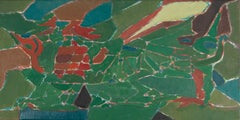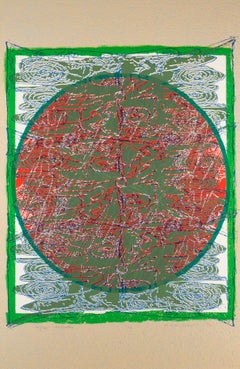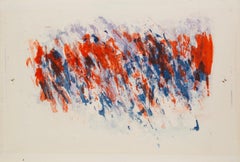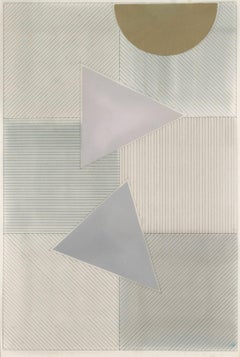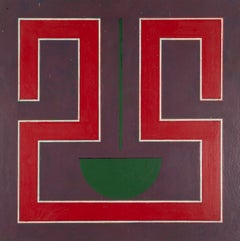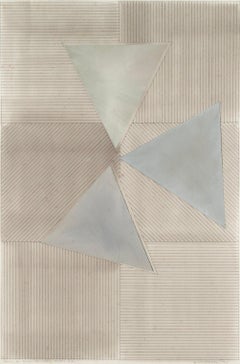Gordon House Art
British, b. 1932
The Guardian wrote of Gordon House, upon his death in 2004:
Many of the works made during his last years by the painter and graphic designer Gordon House, who has died aged 71, referred back to his birthplace in the Swansea valley. He spent his earliest years in the steel town of Pontardawe. In Tin-pan Valley, the memoir he published earlier this year, he recalled "the clamour of steel mills ... the tinplate works and pithead gear" and "dynamite blasting as coal seams were struck higher up the valley".
Unemployment and the depression of the 1930s led Gordon's parents to take him from the valleys of south Wales to the order and designed coherence of Letchworth, "Hertfordshire's first garden city". After leaving school at 14, he went to study, first, at Luton School of Art. For a while after that, he worked in a hospital, before, with the aid of a scholarship, moving on to St Albans School of Art.
By 1961, Gordon had become established among a new generation of artists as an independently minded and adventurous painter and designer. The previous year, he had shown his large, bold, hard-edged canvasses at the important London "Situation" exhibition of large-scale abstract painting, and had designed the catalogue for that exhibition.
As the 1960s moved on, Gordon designed for the pop world. He worked for the Beatles, designing their White album and the back of the Sergeant Pepper album, for which his longtime friend Peter Blake designed the front. Later, he designed Wings' first album. He delighted in the creative energy of others, and so could respond to the talents of musicians and artists alike.
Gordon made paintings throughout his life as a designer. During the 1960s and 70s, his canvasses and prints reflected the dramatic tensions of his graphic design; by the 1980s, Wales had become his constant subject matter. The surface, texture and colour of his paintings softened. No doubt, he needed to pay homage to the places and the people who had shaped him, just as he always paid homage to the artists for whom he designed.
His canvasses reduced in size, becoming palm-of-the-hand landscapes. He spent much time in Wales and, in his final years, he used his brush to walk a path through memories of collieries, valleys, smoking stacks, rows of cottages and the people who had first nurtured him.to
13
4
10
3
7
Overall Width
to
Overall Height
to
32
5
4
5
1
4
10
2
19
12
6
6
4
4
2
2
1
1
1
1
1
1
1
1
1
1
1
1
1
1
1
19
11
11
11
8
39
10,083
2,779
1,379
1,375
20
5
30
7
Artist: Gordon House
The Dragon's Wing, 1990 - Bold Green Abstract Painting with Red and Blue
By Gordon House
Located in Kingsclere, GB
Gordon House was born in 1932 in Pontardawe, South Wales. Early exposure to art on trips to the Glynn Vivian Art Gallery as a young boy inspired House towards creative endeavors and ...
Category
1990s Gordon House Art
Materials
Canvas, Oil
After Powhatan, from the After Powhatan Suite, 1992 - Large Green Abstract Print
By Gordon House
Located in Kingsclere, GB
Gordon House was born in 1932 in Pontardawe, South Wales. Early exposure to art on trips to the Glynn Vivian Art Gallery as a young boy inspired House towards creative endeavors and ...
Category
1990s Gordon House Art
Materials
Screen, Paper
Hornsey, 1957 - Abstract Lithograph Print in Bright Red and Blue
By Gordon House
Located in Kingsclere, GB
Gordon House was born in 1932 in Pontardawe, South Wales. Early exposure to art on trips to the Glynn Vivian Art Gallery as a young boy inspired House towards creative endeavors and ...
Category
Mid-20th Century Gordon House Art
Materials
Lithograph
Ochre, from Study for Larger Tri Motif Series, 1977 - Pale Colours
By Gordon House
Located in Kingsclere, GB
Gordon House was born in 1932 in Pontardawe, South Wales. Early exposure to art on trips to the Glynn Vivian Art Gallery as a young boy inspired House towards creative endeavors and ...
Category
1970s Gordon House Art
Materials
Ink, Watercolor, Gouache
Red Forms with Small Green Segment - Bold 1960s Abstract Oil Painting, Sixties
By Gordon House
Located in Kingsclere, GB
Gordon House was born in 1932 in Pontardawe, South Wales. Early exposure to art on trips to the Glynn Vivian Art Gallery as a young boy inspired House towards creative endeavors and at the age of fourteen he was awarded a grant to enter art school which he accepted. From 1947 to 1950 he studied at Luton School of Art, Bedfordshire, and St. Albans School of Art, Hertfordshire. House's contemporaries included Richard Smith and John Plumb with whom he remained close. During the early fifties, after finishing art school, House began work as assistant to the ecclesiastical sculptor Theodore Kern. He also spent time at an advertising studio where he honed his burgeoning skills in typography and graphic design. In 1952 House was offered the position of designer for Imperial Chemical Industries Plastics Division where he stayed until 1959. This was followed by two years spent as graphic designer for the Kynoch Press in London. In 1961 House set out on his own as a self-employed designer and typographer. Initially this was supplemented by part-time teaching at art schools in and around London but by 1964 House was able to devote himself entirely to his design work which freed up valuable time to concentrate on his own artistic output in the studio.
In the late fifties, informed by the new art emerging from America and that of his contemporaries in England, House began to create large-scale abstract works which he was invited to show in 1959 at Dennis Bowen's legendary New Vision Centre in Marble Arch.
House was an active participant in the vibrant London art scene of the sixties, regularly attending lectures, exhibitions and discussions. In 1960 he exhibited in 'Situation' the key abstract exhibition of the decade held at the RBA Galleries. Other participating artists included Robyn Denny, Bernard and Harold Cohen, Gillian Ayres, John Hoyland, Richard Smith and William Turnbull among others. These artists, united by a common admiration for American Abstract Expressionism, were frustrated by the lack of exposure given to large-scale abstract works in commercial galleries so they organised their own exhibition. The name was derived from the participants' idea that an abstract painting that occupied the whole field of vision would involve the spectator in an 'event' or 'situation'. This exhibition was followed by 'New London Situation' in 1961 and a nationwide touring Arts Council presentation in recognition of the significance of the two earlier shows.
In 1961 House began producing his first prints at the Kelpra Studio, run by Chris and Rose Prater, where he made the earliest fine art screenprint ever to be produced in Britain. Artists such as Paolozzi and Hamilton followed in his footsteps and together they started a printmaking revolution in Britain. They cemented the medium of the screenprint in the world of fine art as opposed to the commercial sphere and secured the reputation of Kelpra in the process. Later, together with Cliff White, House set up the White Ink (Ltd.) print studio in London, where he produced etchings and wood engravings on a series of magnificent antique printing presses...
Category
20th Century Gordon House Art
Materials
Oil, Board
Grey, from Study for Larger Tri Motif Series, c. 1977 - Gouache and Watercolour
By Gordon House
Located in Kingsclere, GB
Gordon House was born in 1932 in Pontardawe, South Wales. Early exposure to art on trips to the Glynn Vivian Art Gallery as a young boy inspired House towards creative endeavors and at the age of fourteen he was awarded a grant to enter art school which he accepted. From 1947 to 1950 he studied at Luton School of Art, Bedfordshire, and St. Albans School of Art, Hertfordshire. House's contemporaries included Richard Smith and John Plumb with whom he remained close. During the early fifties, after finishing art school, House began work as assistant to the ecclesiastical sculptor Theodore Kern. He also spent time at an advertising studio where he honed his burgeoning skills in typography and graphic design. In 1952 House was offered the position of designer for Imperial Chemical Industries Plastics Division where he stayed until 1959. This was followed by two years spent as graphic designer for the Kynoch Press in London. In 1961 House set out on his own as a self-employed designer and typographer. Initially this was supplemented by part-time teaching at art schools in and around London but by 1964 House was able to devote himself entirely to his design work which freed up valuable time to concentrate on his own artistic output in the studio.
In the late fifties, informed by the new art emerging from America and that of his contemporaries in England, House began to create large-scale abstract works which he was invited to show in 1959 at Dennis Bowen's legendary New Vision Centre in Marble Arch.
House was an active participant in the vibrant London art scene of the sixties, regularly attending lectures, exhibitions and discussions. In 1960 he exhibited in 'Situation' the key abstract exhibition of the decade held at the RBA Galleries. Other participating artists included Robyn Denny, Bernard and Harold Cohen, Gillian Ayres, John Hoyland, Richard Smith and William Turnbull among others. These artists, united by a common admiration for American Abstract Expressionism, were frustrated by the lack of exposure given to large-scale abstract works in commercial galleries so they organised their own exhibition. The name was derived from the participants' idea that an abstract painting that occupied the whole field of vision would involve the spectator in an 'event' or 'situation'. This exhibition was followed by 'New London Situation' in 1961 and a nationwide touring Arts Council presentation in recognition of the significance of the two earlier shows.
In 1961 House began producing his first prints at the Kelpra Studio, run by Chris and Rose Prater, where he made the earliest fine art screenprint ever to be produced in Britain. Artists such as Paolozzi and Hamilton followed in his footsteps and together they started a printmaking revolution in Britain. They cemented the medium of the screenprint in the world of fine art as opposed to the commercial sphere and secured the reputation of Kelpra in the process. Later, together with Cliff White, House set up the White Ink (Ltd.) print studio in London, where he produced etchings and wood engravings on a series of magnificent antique printing presses...
Category
20th Century Gordon House Art
Materials
Ink, Watercolor, Gouache
Red Tracery, from the After Powhatan Suite - Large Pink + Green Abstract Print
By Gordon House
Located in Kingsclere, GB
Gordon House 1932-2004
Red Tracery, from the After Powhatan Suite, 1992
unframed, screenprint
101.6 x 71.1 cm
40 x 28 in
signed, titled, dated and numbered 4/20 in pencil
Gordon Hou...
Category
20th Century Abstract Gordon House Art
Materials
Screen
Series 40B, Abstract Geometric Screenprint by Gordon House
By Gordon House
Located in Long Island City, NY
Artist: Gordon House, British (1932 - 2004)
Title: Series 40 C
Year: 1965
Medium: Screenprint, signed and numbered in pencil
Edition: 13/50
Image Size: 16 x 15.5 inches
Frame Size: 2...
Category
1960s Abstract Geometric Gordon House Art
Materials
Screen
Set of 4 Signed Gordon House Limited Edition Etchings 27/30
By Gordon House
Located in Brecon, Powys
Signed, inscribed and dated number 27/30 1998
Originally distrbuted by Alan Cristea Gallery London
Each Frame 11.5" x 9.75"
Gordon House produced many of his own prints first at K...
Category
1990s Abstract Gordon House Art
Materials
Etching
Series 40 - A, Screenprint by Gordon House, 1965
By Gordon House
Located in Long Island City, NY
This screenprint was created by Welsh artist Gordon House (1932-2004). House was a designer and painter whose hard-edged abstract works reflected the dramatic tensions of his graphic...
Category
1960s Abstract Geometric Gordon House Art
Materials
Sequins, Screen
Site Visit, from the FLW/ Highbury Portfolio Suite - 20th C Abstract Print
By Gordon House
Located in Kingsclere, GB
Gordon House 1932-2004
Site Visit, from the FLW/ Highbury Portfolio Suite, 1987
homemade print from an office copy machine
42 x 29.7 cm
16 1/2 x 11 3/4 in
Gordon House was born in 1...
Category
Late 20th Century Abstract Gordon House Art
Materials
Color
Working, from the FLW/ Highbury Portfolio Suite - 20th Century Abstract Print
By Gordon House
Located in Kingsclere, GB
Gordon House 1932-2004
Working, from the FLW/ Highbury Portfolio Suite, 1987
homemade print from an office copy machine
42 x 29.7 cm
16 1/2 x 11 3/4 in
Gordon House was born in 1932...
Category
20th Century Gordon House Art
Materials
Black and White
The Idea, from the FLW/ Highbury Portfolio Suite - 20th Century Abstract Print
By Gordon House
Located in Kingsclere, GB
Gordon House 1932-2004
The Idea, from the FLW/ Highbury Portfolio Suite, 1987
homemade print from an office copy machine
42 x 29.7 cm
16 1/2 x 11 3/4 in
Gordon House was born in 193...
Category
20th Century Gordon House Art
Materials
Black and White
Dial Set One, Geometric Abstract Screenprint by Gordon House
By Gordon House
Located in Long Island City, NY
This screenprint was created by Welsh artist Gordon House (1932-2004). House was a designer and painter whose hard-edged abstract works reflected the dramatic tensions of his graphic...
Category
1960s Abstract Geometric Gordon House Art
Materials
Screen
Gordon House, "Untitled - Red Arcs, " Screenprint, 1969
By Gordon House
Located in Long Island City, NY
This screenprint was created by Welsh artist Gordon House (1932-2004). House was a designer and painter whose hard-edged abstract works reflected the dramatic tensions of his graphic...
Category
1960s Abstract Geometric Gordon House Art
Materials
Screen
Embossed Quarter Arc, Minimalist Geometric Abstract Etching by Gordon House 1970
By Gordon House
Located in Long Island City, NY
This print was created by Welsh artist Gordon House (1932-2004). House was a designer and painter whose hard-edged abstract works reflected the dramatic tensions of his graphic desig...
Category
1970s Minimalist Gordon House Art
Materials
Etching
Still Life at Millbank, Colorful Geometric Abstract Screenprint by Gordon House
By Gordon House
Located in Long Island City, NY
Artist: Gordon House
Title: Still Life at Millbank
Year: 1980
Medium: Screenprint, signed and numbered in pencil
Edition: 88/150
Size: 23.5 x 29.5 in. (59.69 x 74.93 cm)
Frame: 25....
Category
1980s Abstract Geometric Gordon House Art
Materials
Screen
Architecture, from the FLW/ Highbury Portfolio Suite - 20th C Red Abstract Print
By Gordon House
Located in Kingsclere, GB
Gordon House 1932-2004
Architecture, from the FLW/ Highbury Portfolio Suite, 1987
homemade print from an office copy machine
42 x 29.7 cm
16 1/2 x 11 3/4 in
Gordon House was born in...
Category
20th Century Gordon House Art
Materials
Color
Blue Buckler, from the After Powhatan Suite - Large Blue + Green Abstract Print
By Gordon House
Located in Kingsclere, GB
Gordon House 1932-2004
Blue Buckler, from the After Powhatan Suite, 1992
unframed, screenprint
121 x 80.6 cm
47 5/8 x 31 3/4 in
signed, titled, dated and numbered 4/20 in pencil
Gor...
Category
20th Century Abstract Gordon House Art
Materials
Screen
Untitled, circa 2001 - Abstract Oil Painting over Paper Collage
By Gordon House
Located in Kingsclere, GB
Gordon House was born in 1932 in Pontardawe, South Wales. Early exposure to art on trips to the Glynn Vivian Art Gallery as a young boy inspired House towards creative endeavors and ...
Category
Early 2000s Gordon House Art
Materials
Canvas, Oil, Magazine Paper
Late Path II (Antibes) - Abstract Painting with Ochre and Blues
By Gordon House
Located in Kingsclere, GB
Gordon House was born in 1932 in Pontardawe, South Wales. Early exposure to art on trips to the Glynn Vivian Art Gallery as a young boy inspired House towards creative endeavors and ...
Category
Early 2000s Gordon House Art
Materials
Oil, Board
The Project, from the FLW/ Highbury Portfolio Suite - 20th C Red Abstract Print
By Gordon House
Located in Kingsclere, GB
Gordon House 1932-2004
The Project, from the FLW/ Highbury Portfolio Suite, 1987
homemade print from an office copy machine
42 x 29.7 cm
16 1/2 x 11 3/4 in
Gordon House was born in ...
Category
20th Century Gordon House Art
Materials
Color
Still Working, from the FLW/ Highbury Portfolio Suite - 20th C Abstract Print
By Gordon House
Located in Kingsclere, GB
Gordon House 1932-2004
Still Working, from the FLW/ Highbury Portfolio Suite, 1987
homemade print from an office copy machine
42 x 29.7 cm
16 1/2 x 11 3/4 in
Gordon House was born i...
Category
20th Century Gordon House Art
Materials
Black and White
Arc in Register, 1970 - Oil, Bold Abstract Painting
By Gordon House
Located in Kingsclere, GB
Gordon House was born in 1932 in Pontardawe, South Wales. Early exposure to art on trips to the Glynn Vivian Art Gallery as a young boy inspired House towards creative endeavors and at the age of fourteen he was awarded a grant to enter art school which he accepted. From 1947 to 1950 he studied at Luton School of Art, Bedfordshire, and St. Albans School of Art, Hertfordshire. House's contemporaries included Richard Smith and John Plumb with whom he remained close. During the early fifties, after finishing art school, House began work as assistant to the ecclesiastical sculptor Theodore Kern. He also spent time at an advertising studio where he honed his burgeoning skills in typography and graphic design. In 1952 House was offered the position of designer for Imperial Chemical Industries Plastics Division where he stayed until 1959. This was followed by two years spent as graphic designer for the Kynoch Press in London. In 1961 House set out on his own as a self-employed designer and typographer. Initially this was supplemented by part-time teaching at art schools in and around London but by 1964 House was able to devote himself entirely to his design work which freed up valuable time to concentrate on his own artistic output in the studio.
In the late fifties, informed by the new art emerging from America and that of his contemporaries in England, House began to create large-scale abstract works which he was invited to show in 1959 at Dennis Bowen's legendary New Vision Centre in Marble Arch.
House was an active participant in the vibrant London art scene of the sixties, regularly attending lectures, exhibitions and discussions. In 1960 he exhibited in 'Situation' the key abstract exhibition of the decade held at the RBA Galleries. Other participating artists included Robyn Denny, Bernard and Harold Cohen, Gillian Ayres, John Hoyland, Richard Smith and William Turnbull among others. These artists, united by a common admiration for American Abstract Expressionism, were frustrated by the lack of exposure given to large-scale abstract works in commercial galleries so they organised their own exhibition. The name was derived from the participants' idea that an abstract painting that occupied the whole field of vision would involve the spectator in an 'event' or 'situation'. This exhibition was followed by 'New London Situation' in 1961 and a nationwide touring Arts Council presentation in recognition of the significance of the two earlier shows.
In 1961 House began producing his first prints at the Kelpra Studio, run by Chris and Rose Prater, where he made the earliest fine art screenprint ever to be produced in Britain. Artists such as Paolozzi and Hamilton followed in his footsteps and together they started a printmaking revolution in Britain. They cemented the medium of the screenprint in the world of fine art as opposed to the commercial sphere and secured the reputation of Kelpra in the process. Later, together with Cliff White, House set up the White Ink (Ltd.) print studio in London, where he produced etchings and wood engravings on a series of magnificent antique printing presses...
Category
20th Century Gordon House Art
Materials
Canvas, Oil
Untitled - Large Pink Painting over Paper Collage
By Gordon House
Located in Kingsclere, GB
Gordon House was born in 1932 in Pontardawe, South Wales. Early exposure to art on trips to the Glynn Vivian Art Gallery as a young boy inspired House towards creative endeavors and ...
Category
Early 2000s Gordon House Art
Materials
Canvas, Oil, Magazine Paper
Double Red Triangle, 1974 - Geometric Abstract Acrylic Painting
By Gordon House
Located in Kingsclere, GB
Gordon House was born in 1932 in Pontardawe, South Wales. Early exposure to art on trips to the Glynn Vivian Art Gallery as a young boy inspired House towards creative endeavors and ...
Category
20th Century Gordon House Art
Materials
Canvas, Acrylic
Blue/Red Ornament Frieze II, 1976-77 - Large Bold, Bright Abstract Painting
By Gordon House
Located in Kingsclere, GB
Gordon House 1932-2004
Blue/Red Ornament Frieze II, 1976-1977
with Artist's label attached to the stretcher bar
acrylic on canvas
91 x 91 cm
35 7/8 x 35 7/8 in
Gordon House was born in 1932 in Pontardawe, South Wales. Early exposure to art on trips to the Glynn Vivian Art Gallery as a young boy inspired House towards creative endeavors and at the age of fourteen he was awarded a grant to enter art school which he accepted. From 1947 to 1950 he studied at Luton School of Art, Bedfordshire, and St. Albans School of Art, Hertfordshire. House's contemporaries included Richard Smith and John Plumb with whom he remained close. During the early fifties, after finishing art school, House began work as assistant to the ecclesiastical sculptor Theodore Kern. He also spent time at an advertising studio where he honed his burgeoning skills in typography and graphic design. In 1952 House was offered the position of designer for Imperial Chemical Industries Plastics Division where he stayed until 1959. This was followed by two years spent as graphic designer for the Kynoch Press in London. In 1961 House set out on his own as a self-employed designer and typographer. Initially this was supplemented by part-time teaching at art schools in and around London but by 1964 House was able to devote himself entirely to his design work which freed up valuable time to concentrate on his own artistic output in the studio.
In the late fifties, informed by the new art emerging from America and that of his contemporaries in England, House began to create large-scale abstract works which he was invited to show in 1959 at Dennis Bowen's legendary New Vision Centre in Marble Arch.
House was an active participant in the vibrant London art scene of the sixties, regularly attending lectures, exhibitions and discussions. In 1960 he exhibited in 'Situation' the key abstract exhibition of the decade held at the RBA Galleries. Other participating artists included Robyn Denny, Bernard and Harold Cohen, Gillian Ayres, John Hoyland, Richard Smith and William Turnbull among others. These artists, united by a common admiration for American Abstract Expressionism, were frustrated by the lack of exposure given to large-scale abstract works in commercial galleries so they organised their own exhibition. The name was derived from the participants' idea that an abstract painting that occupied the whole field of vision would involve the spectator in an 'event' or 'situation'. This exhibition was followed by 'New London Situation' in 1961 and a nationwide touring Arts Council presentation in recognition of the significance of the two earlier shows.
In 1961 House began producing his first prints at the Kelpra Studio, run by Chris and Rose Prater, where he made the earliest fine art screenprint ever to be produced in Britain. Artists such as Paolozzi and Hamilton followed in his footsteps and together they started a printmaking revolution in Britain. They cemented the medium of the screenprint in the world of fine art as opposed to the commercial sphere and secured the reputation of Kelpra in the process. Later, together with Cliff White, House set up the White Ink (Ltd.) print studio in London, where he produced etchings and wood engravings on a series of magnificent antique printing...
Category
20th Century Abstract Geometric Gordon House Art
Materials
Canvas, Acrylic
Red/Green Ornament Frieze I - Bold Green and Red Shapes, Abstract Oil Painting
By Gordon House
Located in Kingsclere, GB
Gordon House 1932-2004
Red/Green Ornament Frieze I, 1976-1977
signed and dated on the canvas overlap
acrylic on canvas
91 x 91 cm
35 7/8 x 35 7/8 in
Gordon House was born in 1932 in Pontardawe, South Wales. Early exposure to art on trips to the Glynn Vivian Art Gallery as a young boy inspired House towards creative endeavors and at the age of fourteen he was awarded a grant to enter art school which he accepted. From 1947 to 1950 he studied at Luton School of Art, Bedfordshire, and St. Albans School of Art, Hertfordshire. House's contemporaries included Richard Smith and John Plumb with whom he remained close. During the early fifties, after finishing art school, House began work as assistant to the ecclesiastical sculptor Theodore Kern. He also spent time at an advertising studio where he honed his burgeoning skills in typography and graphic design. In 1952 House was offered the position of designer for Imperial Chemical Industries Plastics Division where he stayed until 1959. This was followed by two years spent as graphic designer for the Kynoch Press in London. In 1961 House set out on his own as a self-employed designer and typographer. Initially this was supplemented by part-time teaching at art schools in and around London but by 1964 House was able to devote himself entirely to his design work which freed up valuable time to concentrate on his own artistic output in the studio.
In the late fifties, informed by the new art emerging from America and that of his contemporaries in England, House began to create large-scale abstract works which he was invited to show in 1959 at Dennis Bowen's legendary New Vision Centre in Marble Arch.
House was an active participant in the vibrant London art scene of the sixties, regularly attending lectures, exhibitions and discussions. In 1960 he exhibited in 'Situation' the key abstract exhibition of the decade held at the RBA Galleries. Other participating artists included Robyn Denny, Bernard and Harold Cohen, Gillian Ayres, John Hoyland, Richard Smith and William Turnbull among others. These artists, united by a common admiration for American Abstract Expressionism, were frustrated by the lack of exposure given to large-scale abstract works in commercial galleries so they organised their own exhibition. The name was derived from the participants' idea that an abstract painting that occupied the whole field of vision would involve the spectator in an 'event' or 'situation'. This exhibition was followed by 'New London Situation' in 1961 and a nationwide touring Arts Council presentation in recognition of the significance of the two earlier shows.
In 1961 House began producing his first prints at the Kelpra Studio, run by Chris and Rose Prater, where he made the earliest fine art screenprint ever to be produced in Britain. Artists such as Paolozzi and Hamilton followed in his footsteps and together they started a printmaking revolution in Britain. They cemented the medium of the screenprint in the world of fine art as opposed to the commercial sphere and secured the reputation of Kelpra in the process. Later, together with Cliff White, House set up the White Ink (Ltd.) print studio in London, where he produced etchings and wood engravings on a series of magnificent antique printing...
Category
1970s Gordon House Art
Materials
Canvas, Acrylic
Grey/Pink, from Study for Larger Tri Motif Series, 1977 - Gouache, Watercolour
By Gordon House
Located in Kingsclere, GB
Gordon House was born in 1932 in Pontardawe, South Wales. Early exposure to art on trips to the Glynn Vivian Art Gallery as a young boy inspired House towards creative endeavors and ...
Category
20th Century Gordon House Art
Materials
Ink, Watercolor, Gouache
Inner and Outer Arc, 1970 - Geometric Abstract Painting
By Gordon House
Located in Kingsclere, GB
Gordon House was born in 1932 in Pontardawe, South Wales. Early exposure to art on trips to the Glynn Vivian Art Gallery as a young boy inspired House towards creative endeavors and ...
Category
1970s Gordon House Art
Materials
Oil, Board
Mitred Matrix (Red), 1968 - Bold 1960s Abstract Oil Painting, Geometric Forms
By Gordon House
Located in Kingsclere, GB
Gordon House 1932-2004
Mitred Matrix (Red), 1968
oil on canvas
152.5 x 152.5 cm
60 x 60 in
unsigned, though from the Estate of the Artist
Gordon House was born in 1932 in Pontardaw...
Category
20th Century Gordon House Art
Materials
Canvas, Oil
Untitled - Large Blue Painting with Blue and Red, Bold Geometric Shapes
By Gordon House
Located in Kingsclere, GB
Gordon House was born in 1932 in Pontardawe, South Wales. Early exposure to art on trips to the Glynn Vivian Art Gallery as a young boy inspired House towards creative endeavors and ...
Category
21st Century and Contemporary Gordon House Art
Materials
Canvas, Oil
Common Event, Minimalist Geometric Etching by Gordon House
By Gordon House
Located in Long Island City, NY
This print was created by Welsh artist Gordon House (1932-2004). House was a designer and painter whose hard-edged abstract works reflected the dramatic tensions of his graphic desig...
Category
1970s Minimalist Gordon House Art
Materials
Etching
Scooped Palette - Large Green Painting with Bold Geometric Shapes, Abstracted
By Gordon House
Located in Kingsclere, GB
Gordon House was born in 1932 in Pontardawe, South Wales. Early exposure to art on trips to the Glynn Vivian Art Gallery as a young boy inspired House towards creative endeavors and ...
Category
21st Century and Contemporary Gordon House Art
Materials
Canvas, Oil
Highway - Bold Abstract Painting with Red, Blue and Green
By Gordon House
Located in Kingsclere, GB
Gordon House was born in 1932 in Pontardawe, South Wales. Early exposure to art on trips to the Glynn Vivian Art Gallery as a young boy inspired House towards creative endeavors and ...
Category
1990s Gordon House Art
Materials
Canvas, Oil
Red/Green, from Study for Larger Tri Motif Series, 1977 - Gouache, Watercolour
By Gordon House
Located in Kingsclere, GB
Gordon House was born in 1932 in Pontardawe, South Wales. Early exposure to art on trips to the Glynn Vivian Art Gallery as a young boy inspired House towards creative endeavors and at the age of fourteen he was awarded a grant to enter art school which he accepted. From 1947 to 1950 he studied at Luton School of Art, Bedfordshire, and St. Albans School of Art, Hertfordshire. House's contemporaries included Richard Smith and John Plumb with whom he remained close. During the early fifties, after finishing art school, House began work as assistant to the ecclesiastical sculptor Theodore Kern. He also spent time at an advertising studio where he honed his burgeoning skills in typography and graphic design. In 1952 House was offered the position of designer for Imperial Chemical Industries Plastics Division where he stayed until 1959. This was followed by two years spent as graphic designer for the Kynoch Press in London. In 1961 House set out on his own as a self-employed designer and typographer. Initially this was supplemented by part-time teaching at art schools in and around London but by 1964 House was able to devote himself entirely to his design work which freed up valuable time to concentrate on his own artistic output in the studio.
In the late fifties, informed by the new art emerging from America and that of his contemporaries in England, House began to create large-scale abstract works which he was invited to show in 1959 at Dennis Bowen's legendary New Vision Centre in Marble Arch.
House was an active participant in the vibrant London art scene of the sixties, regularly attending lectures, exhibitions and discussions. In 1960 he exhibited in 'Situation' the key abstract exhibition of the decade held at the RBA Galleries. Other participating artists included Robyn Denny, Bernard and Harold Cohen, Gillian Ayres, John Hoyland, Richard Smith and William Turnbull among others. These artists, united by a common admiration for American Abstract Expressionism, were frustrated by the lack of exposure given to large-scale abstract works in commercial galleries so they organised their own exhibition. The name was derived from the participants' idea that an abstract painting that occupied the whole field of vision would involve the spectator in an 'event' or 'situation'. This exhibition was followed by 'New London Situation' in 1961 and a nationwide touring Arts Council presentation in recognition of the significance of the two earlier shows.
In 1961 House began producing his first prints at the Kelpra Studio, run by Chris and Rose Prater, where he made the earliest fine art screenprint ever to be produced in Britain. Artists such as Paolozzi and Hamilton followed in his footsteps and together they started a printmaking revolution in Britain. They cemented the medium of the screenprint in the world of fine art as opposed to the commercial sphere and secured the reputation of Kelpra in the process. Later, together with Cliff White, House set up the White Ink (Ltd.) print studio in London, where he produced etchings and wood engravings on a series of magnificent antique printing presses...
Category
20th Century Gordon House Art
Materials
Ink, Watercolor, Gouache
III, from Tri Motifs, 1977 - Bold Shapes, Orange, Green, Gouache and Watercolour
By Gordon House
Located in Kingsclere, GB
Gordon House was born in 1932 in Pontardawe, South Wales. Early exposure to art on trips to the Glynn Vivian Art Gallery as a young boy inspired House towards creative endeavors and ...
Category
20th Century Gordon House Art
Materials
Ink, Watercolor, Gouache
Gordon House art for sale on 1stDibs.
Find a wide variety of authentic Gordon House art available for sale on 1stDibs. If you’re browsing the collection of art to introduce a pop of color in a neutral corner of your living room or bedroom, you can find work that includes elements of red, blue and other colors. You can also browse by medium to find art by Gordon House in screen print, etching, lithograph and more. Much of the original work by this artist or collective was created during the 20th century and is mostly associated with the abstract style. Not every interior allows for large Gordon House art, so small editions measuring 10 inches across are available. Customers who are interested in this artist might also find the work of Ben Nicholson, Georg Karl Pfahler, and Marc Vaux. Gordon House art prices can differ depending upon medium, time period and other attributes. On 1stDibs, the price for these items starts at $750 and tops out at $2,950, while the average work can sell for $1,205.
